‘This was going to be a tidal wave’: What makes pandemic grief similar to violent death grief
Researchers find that pandemic grief is on par with violent-death grief — and what makes both so traumatic
Listen 14:28
A woman passes a fence outside Brooklyn's Green-Wood Cemetery adorned with tributes to victims of COVID-19. Researchers estimate that millions of people around the world are affected by pandemic grief. (AP Photo/Mark Lennihan)
This story is from The Pulse, a weekly health and science podcast.
Find it on Apple Podcasts, Spotify, or wherever you get your podcasts.
When COVID-19 first hit, grief and loss researcher Bob Neimeyer knew we were heading into a storm with a very long tail.
“We recognized this was going to be a tidal wave that we really have what I came to call a shadow pandemic of grief,” Neimeyer said.
Neimeyer and psychologist Sherman Lee developed what they called the pandemic grief scale, to identify cases of dysfunctional grief associated with deaths that have taken place since the start of COVID-19 — dysfunctional, meaning it impairs someone’s ability to work, take care of children, and maintain relationships.
Among the symptoms that predicted the highest levels of dysfunction:
- Wishing they were dead so they could be with their loved one
- Inability to care about anything
- Inability to access positive memories of their loved one, and instead being preoccupied by the trauma of their loss
- A sense of emptiness and purposelessness
- Substance abuse and dependency
- Increased risk of suicide
Neimeyer and his co-author surveyed more than 800 Americans who lost loved ones during the pandemic — whether from COVID-19 or some other cause — and what they found was that two-thirds of respondents were suffering from dysfunctional grief, or as they called it, “pandemic grief.”
‘Pandemic grief’ goes beyond normal grief
One of their most interesting findings was that people who lost loved ones during the pandemic suffered symptoms that were on par, or even worse, than people who’d lost loved ones in what we might think of as much more traumatic way.s
“When we compared [people suffering from pandemic grief] to samples of people who suffered very traumatic losses in the pre-2019 era, what we found was that the current samples were off the charts with reference to their functional impairment,” Neimeyer said.
The severity of their symptoms were on par with those of people diagnosed with complicated grief and prolonged grief disorder.
Part of what made this finding noteworthy was that it contradicted research about grief associated with natural versus unnatural deaths.
With so-called “natural deaths” — deaths resulting from age or illness — grief is less complicated, if no less painful.
Grief resulting from violent deaths, on the other hand, is often marked by debilitating symptoms.
Technically, dying from COVID-19 counts as a natural death. But the grief Neimeyer was seeing looked more like violent-death bereavement.
“So many COVID deaths left people with, first of all, a sense of shock and horror,” Neimeyer said.
The shock, he said, of dealing with a sudden, unexpected death — and the horror of imagining their loved ones hooked up to machines, struggling for life in isolation.
“And then there’s the comparable sense of helplessness,” he said. “There’s nothing we can do. We can’t even provide tending and befriending and comforting adequately to our loved ones. And the same occurs in the context of violent death bereavement.”
Pandemic and violent-death bereavement also share anger, limitations in social support, unanswerable “why” questions, traumatic images, and guilt.
It was almost as if “pandemic grief” was its own, all-new category of grief — one that broke the rules of what he’s traditionally known about bereavement.
What makes pandemic losses so traumatic?
Neimeyer and his co-author also made another unexpected discovery — pandemic grief wasn’t just limited to those who’d lost loved ones to COVID-19.
“It didn’t matter what you died of,” Neimeyer said. “Your loved one could die of suicide. Your loved one could die of dementia. And yet people experienced many of the same struggles and comparable levels of grief, which completely surprised us.”
That led Neimeyer and his co-author to another question: If the trauma doesn’t stem from the cause of death itself, what is it that makes pandemic losses so difficult?
To find out, they looked at the context of the deaths that led to the most extreme symptoms. They found one major commonality: being separated from their loved one — losing their chance to say goodbye.
“Not being able to be there with a loved one at the end of their life,” Neimeyer said. “Feeling a kind of emotional distance from them when the only medium of contact was an iPad or a tablet.”
They missed their chance, not only to say goodbye, but to care for and help usher their loved ones into death.

“We may hold their hand and talk as long as their strength permits about shared memories,” Neimeyer said. “We may go over photo albums. We may brush their hair or give them a shave. These intimate moments of bonding and expression, sometimes of gratitude, of love, but also sometimes expression of forgiveness or the asking of forgiveness, have a deep meaning and purpose for people. And when they are denied those opportunities, what we find is that complications do arise.”
During the worst parts of the pandemic, that separation was universal — regardless of how a loved one died.
“All of these people, all of these families, were blocked from attending their loved ones,” Neimeyer said. “And as we move on from the pandemic, even as it lingers and continues to take thousands of lives daily, we are now turning a deaf ear to the distress of those who experienced and continue to experience losses in this era. And I think that sense of social isolation, abandonment, what we might call disenfranchised grief, where we no longer are willing to spend time listening to it and providing comfort — these complications could roll forward for a long time, increasing the probability of prolonged grief disorder.”
Lessons from violent-death bereavement
There’s isn’t yet a guide for dealing with pandemic grief — but there is guidance on dealing with grief resulting from sudden, violent death.
In 2009, psychotherapist Kathleen O’Hara published a book called “A Grief Like No Other: Surviving the Violent Death of Someone You Love.”
“Certainly any death is tragic,” O’Hara said, “but when you don’t get to say goodbye — you don’t get to say anything — it leaves you completely on the other side of the grief.”

O’Hara has first-hand experience with sudden, violent death. Twenty-three years ago, her college-aged son, Aaron, was kidnapped and shot to death. She still remembers the moment she got the news.
“I remember holding the phone,” she said. “And you know that when people say their blood runs cold? That’s what it felt like. And I was swirling into disbelief. Like, this cannot be happening.”
O’Hara says shock is partly a defense mechanism — something that helps us stay standing at a moment when our sense of reality has crumbled. It’s knowing something terrible is true, and yet not fully believing it at the same time.
“I remember being in the funeral home, and of course, I never got to see him,” she said. “So the casket was there. And I remember thinking, ‘Well, maybe he’s not in there.’ Because I had nothing to anchor it, except obviously there’s this casket. But how do I know who’s in there? I mean, these crazy things that you think in grief, your mind is not exactly functioning.”
A big part of the grieving process, Bob Neimeyer says, is figuring out how to accommodate that new reality.
“It changes the way we think about the world, the way we think about ourselves,” he said. “The question is, how do we live with it? Do we hold the grief, or does the grief hold us? Do we find meaning in the life that we have? Can we experience moments of joy and gratitude? Or are we just simply swallowed up in bitterness and darkness and refusal of the tragic beauty of this world?”
It’s these questions and more that O’Hara reckons with in her book, which she began writing five years after her son’s death.
In it, she talks about grief as an ocean – one that can drown you if you don’t find a way to survive — and dealing with it as a process of getting back to shore.
One of the first things you have to do, she says, is learn how to float: find the qualities within yourself that can help you manage your grief, like courage, hope, faith, spirituality, and optimism.
“I call them life preservers,” she said. “We’re in the ocean of grief, and we’re going to drown, and we need to find things within ourselves. And these are all human qualities that can help us not only survive, but ultimately live again.”
Next, O’Hara says, you have to find your “lighthouses in the harbor” — family and friends who can give you guidance and support.
Once you’re not actively drowning, one of the hardest parts begins: learning how to ride the waves of grief — overwhelming feelings of sadness, anger and hopelessness.
“And of course, once you’ve learned how to ride them, it takes you into the deepest part of the ocean,” O’Hara said.
At that point, it’s necessary to cultivate practices that can help you get back to shore.
“Those are things like gratitude and forgiveness,” O’Hara said. “How we’re going to come to terms with this grief and the depth of the feelings and the experience.”
Subscribe to The Pulse
Finding your way out of the ocean involves transmuting your despair into something productive — taking ownership of your story and the grief within it, and turning it into something creative: art, writing, music, a foundation; something that honors the one you lost.
Eventually, O’Hara says, you’ll be able to come out of the ocean and swim to shore — or as she calls it, “the new world” — where you can begin once again thinking about the future.
“How we’re going to live again, how we’re going to face this new world without the ones we love,” she said.
Surviving the immediate aftermath
The process O’Hara lays out is a longer-term strategy. So what helped her the most in the first few years after her son’s death?
She says one big thing was facing her feelings.
“I knew how to deal with feelings,” she said. “I was completely unprepared, by the way, for the depth of those feelings. But I knew that if you can feel them and deal with them, you will heal from them. It’s the running away from them that causes the problems because we’re so scared of the feelings, because they’re so overwhelming.”
She says some of those feelings never go away — and the goal isn’t to make them go away. It’s to transform how you live with your grief. For people who lose loved ones in sudden and traumatic ways, that means getting over the initial shock and horror.
“So, for example, this happened 23 years ago,” she said. “I don’t think of the event, the circumstances of his death, thankfully. I’ve been able to go through that.”
What hasn’t changed, she said, is the missing — the pure longing for her son.
“I think that that will stay,” she said. “It doesn’t have to to immobilize you, but it certainly becomes that. And I think in terms of grief, that’s a good outcome — that’s a good outcome.”
Once you deal with the trauma and PTSD, she says, it becomes possible to accept your loved one’s death — and to then move forward in your relationship with them.
“I personally don’t believe in leaving the person behind,” O’Hara said. “I think that person stays in your heart, and you have a different kind of relationship with them.”
Bob Neimeyer agrees with O’Hara.
“I think maybe the goal is not so much to say goodbye, but in the words of a famous social worker, Michael White, to say hello again,” he said. “How do we continue the conversation? How do we not so much seek to finish business, but to continue it with the loved one,but in a healthy way?”
Neimeyer offered some of his own suggestions: rituals, like setting a place at the table for your deceased loved one; writing them letters — and maybe even answering them; taking long walks, and having talks with them in your head.
“Time does not heal all wounds — it’s a question of what we do with the time,” he said. “And when we find ways of somehow taking in and making a place for this sad, sometimes tragic event that happened, it becomes part of our life story. It becomes a tellable tale.”
And in telling our tale, we’re able to connect with others who may have shared the same experience.
“It’s never too late to memorialize our loved ones,” he said. “Just because we missed the obvious opportunity doesn’t mean we can’t invent another.”
Write that letter,” O’Hara added. “Take that walk in nature and talk to that person and say goodbye. You can do that. It’s obviously not what we want, but we also have to realize, we have to work with what we have.”
WHYY is your source for fact-based, in-depth journalism and information. As a nonprofit organization, we rely on financial support from readers like you. Please give today.







